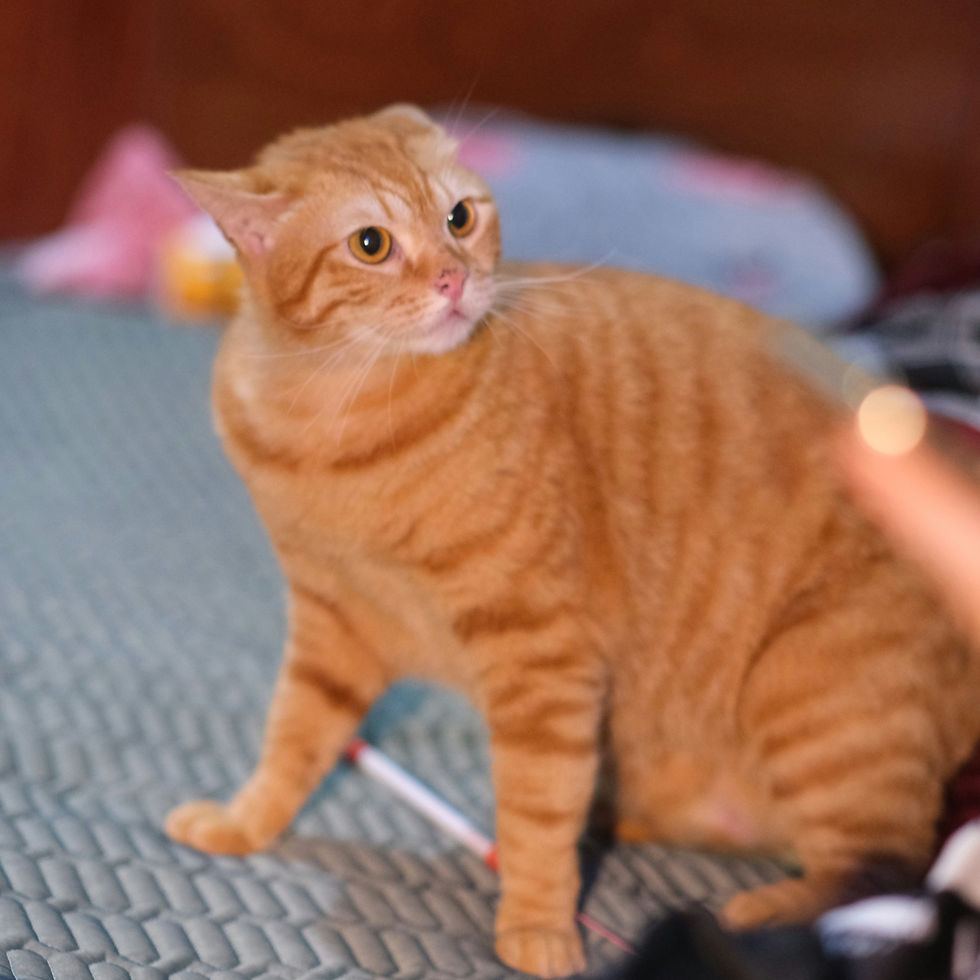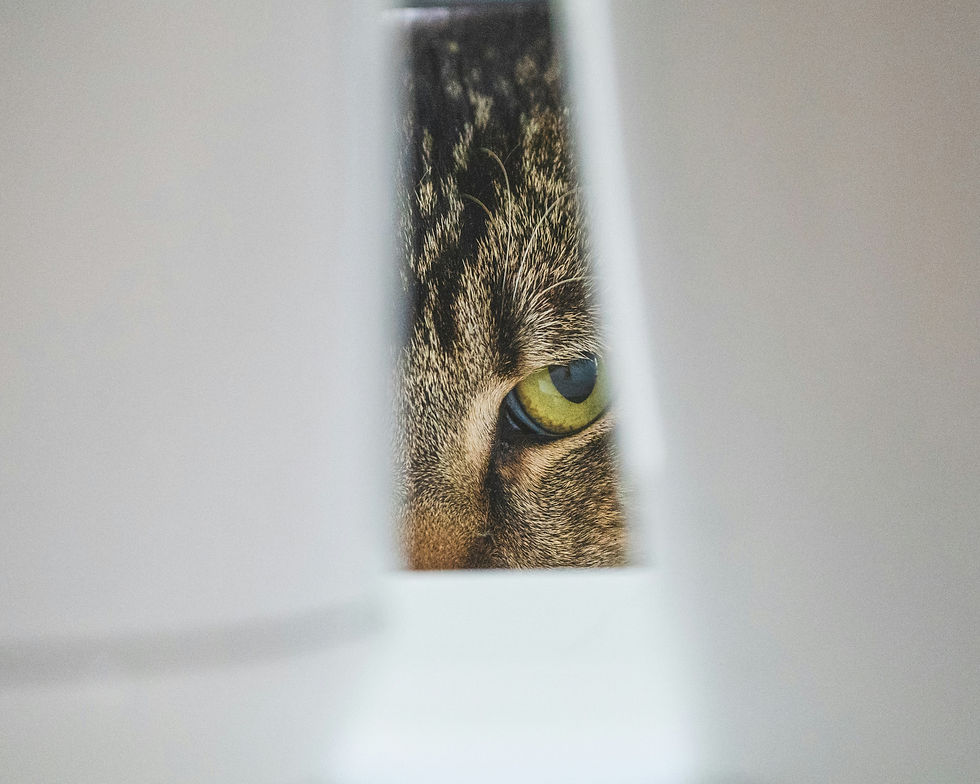Tips and Tricks for Working with Shy Cats
- Sara LeClair

- Aug 12
- 4 min read
Updated: Aug 13
Shyness is most obvious when the kitty runs and hides. Here are some common body language cues:
Tail low to the ground, tucked under the body, or curled over the paws
Pupils dilated
Ears swiveling or facing towards the floor
It’s important to know the difference between ears facing down and pulled back to the sides of their head (this is a warning) versus ears facing down and pointed away from the body (this shows their desire to hide, but still be able to hear what’s going on around them. You’ll see this most often when they are in sky boxes).
How do we help shy cats relax?
The first thing you need to do if you want to help your feline friend relax is observe their body language. Shy cats can be broken down into three categories:
Shy-Affectionate
Shy-Aggressive
Shutdown-shy
Each category requires a different approach, so I’ve laid out what each one is, and how to deal with them.
Shy-Affectionate

These kitties are too nervous to come out on their own. All they need is for you to bridge the gap and pet them, and then they become the biggest love bugs! They need lots of calm, gentle pets.
If you’re not sure if your furry friend is shy-affectionate, try letting them sniff your hand. Make sure you approach them with your hand low—below the level of their head. This keeps them from seeing your hand as a threat, and they will be more receptive. In addition, offer the back of your hand instead of the palm, as this can also be less threatening.
Pay attention to the position of their whiskers—especially if you can’t see the rest of their body. If they are fanned forward (and remain that way after the initial sniffs) then this is an invitation for pets, if they haven’t already started rubbing on your hand. If the whiskers are pulled back, don’t try to pet the cat—this is a silent warning.
Brushing a cat is another way to help build a close bond. When brushing a cat, it’s best to hold the brush and let them smell and rub on it, without moving it. Most cats prefer to brush themselves. Being a passive brush-holder also helps to avoid overstimulation, since the cats can stop when they want to.

Shy-Aggressive
Often times, the kitties who are shy-aggressive are really just afraid of people. In order to help them relax, you have to let them know they can trust you. This means you have to pay extra close attention to their body language. Some common warning signs that the cat is about to swat or bite are:
Hissing
Growling
Whiskers pulled back to the face
Ears pinned to the head
Hard stares at your hands, arms, legs, or face
A cat who is shy-aggressive will prefer to hide than attack, and in each of these examples, you should back off slowly and calmly. This tells the cat that you understand its warning, and you’re respecting its space.
A cat like this will require a lot of quiet quality time to build up the trust and courage to approach you. This means you’ll have to sit with the kitty often and for long periods of time.
When sitting with a shy-aggressive cat, make sure to:
Sit with your back, or the side of your body, facing the cat. This is very non-threatening and will help put your kitty at ease because you’re showing that you trust it.
Stay quiet. Too much talking can make a shy cat more nervous, especially if they don’t know you. Cats don’t usually meow at one another in the natural world, so they often prefer the quiet.
Give them some slow blinks or close your eyes around them for a while. This shows you trust them and mean them no harm. When you close your eyes, you also make yourself seem more approachable and your kitty will be more likely to come out.
Leaving treats in the room when you leave or giving them while you’re inside is a good way to build a positive association. And don’t forget the power of Feliway! A little Feliway can go a long way in helping a cat relax.

Shutdown-Shy
This is the most difficult kind of shyness to work with, as the cats in this state are usually so scared they won’t leave their hiding spot to eat or use their litter box. They are the kind that will let you pet them because they are too petrified to move. Most often, they quite literally seem to have been ‘shut down’.
These cats require a lot of one-on-one time and careful care and attention. They will need Feliway in their room each day, and make sure they have plenty of hiding places. If the kitty will allow it, give them gentle rubs along their cheeks and chin scratches, even if they don’t rub on your hand, this can help them start to relax. Do NOT continue petting them if they hiss or pull away from you.
Cats like this will need a lot of playtime sessions to build their confidence. I usually start by using the stick end of a peacock feather, as sometimes the feathered end can seem foreign and a little scary to them. You can also use the Da Bird wands for these kitties. I usually keep it skittering along on the ground until they are more comfortable in their rooms—sometimes it will scare them if it’s flying around.
As the days pass and they become more comfortable, start removing some of their hiding places. This encourages them to explore and realize that the outside world isn’t so scary.
Conclusion
Helping shy cats come out of their shells requires patience, understanding, and a tailored approach based on their specific type of shyness. Whether your feline friend is Shy-Affectionate, Shy-Aggressive, or Shutdown-Shy, the key is to observe their body language and respond with gentle, non-threatening actions. By providing a calm environment, using positive reinforcement, and gradually building trust, you can help your shy cat feel more comfortable and confident. Remember, every small step forward is a victory, and with time and dedication, your shy kitty can become a loving and affectionate companion.
.png)



Comments